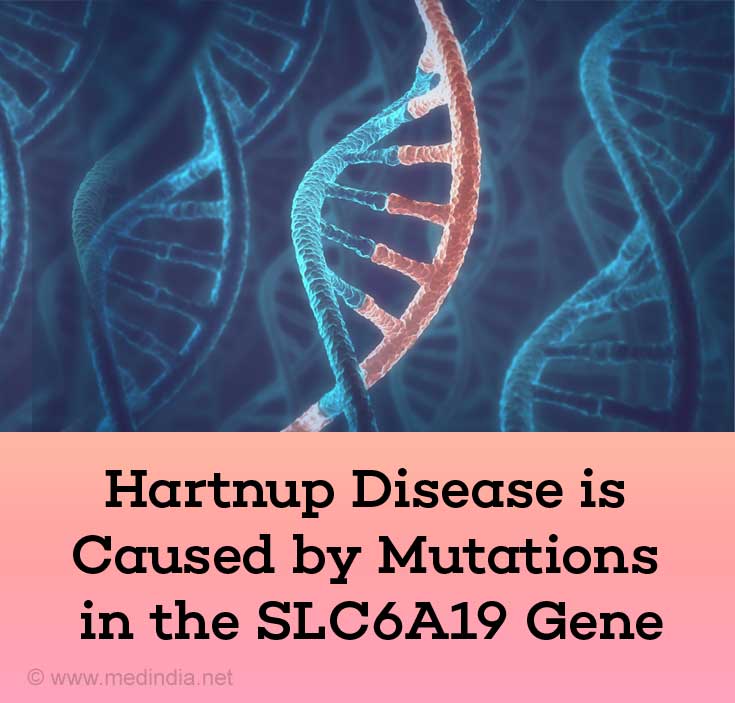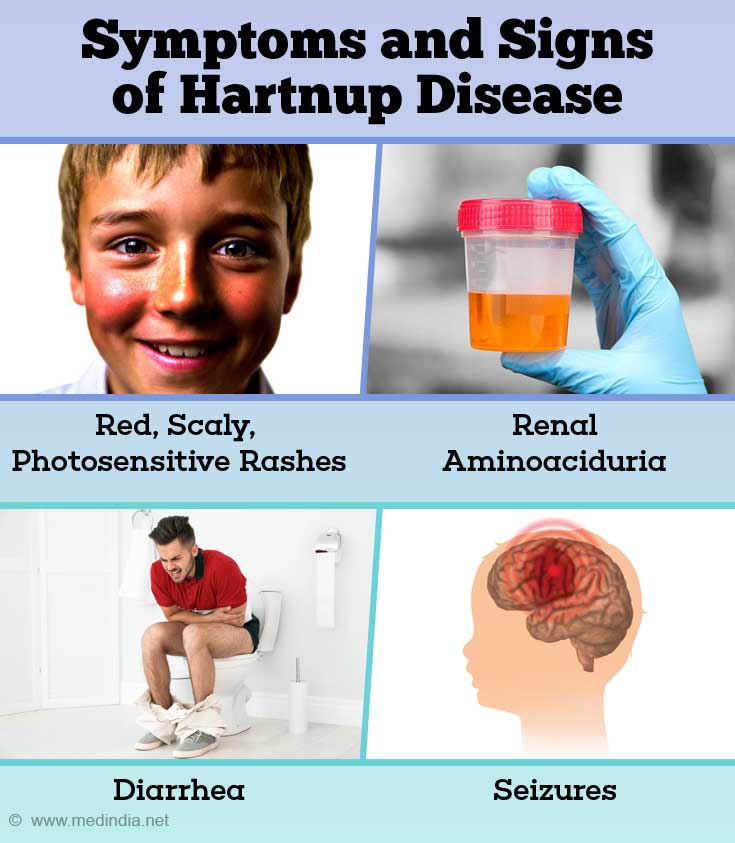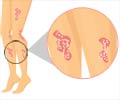- Hartnup disease - (https://ghr.nlm.nih.gov/condition/hartnup-disease)
- What is Hartnup Disease - (https://rarediseases.org/rare-diseases/hartnup-disease/)
- Know Hartnup Disease - (http://flipper.diff.org/app/items/3959)
- Introduction to Hartnup Disorder - (https://themedicalbiochemistrypage.org/hartnup-disorder.php)
- Hartnup Disease Learning Center - (http://healthtools.aarp.org/learning-center/hartnup-disease)
What is Hartnup Disease?
Hartnup disease or Hartnup disorder is a rare genetic condition which causes abnormal absorption and excretion of tryptophan and other amino acids from your body. Amino acids are essential building blocks for producing proteins and vitamins in your body. As a result of this inborn error of amino acid metabolism, it is difficult for your body to absorb certain amino acids from your intestine and kidneys. Hence people with Hartnup disease have high levels of amino acids in their urine (aminoaciduria).
The amino acids affected include tryptophan, alanine, asparagine, glutamine, histidine, isoleucine, leucine, phenylalanine, serine, threonine, tyrosine and valine.
Hartnup disease was first described in the Hartnup family in England in 1956 by Baron et al. Hartnup disease is also known as "Pellagra-like dermatosis” as it causes a red scaly skin rash, usually when skin is exposed to sunlight similar to pellagra (a disease caused due to deficiency of Vitamin B3 or Niacin in the body.)
Deficiency of the amino acid tryptophan is believed to cause the symptoms associated with Hartnup disease. The inability of your body to absorb amino acids, particularly tryptophan causes skin rashes, gross aminoaciduria, difficulty in coordinating movements, and psychiatric symptoms such as depression or psychosis.
Tryptophan is not only used in the formation of protein, but it is also converted into serotonin, melatonin and niacin. Serotonin is a neurotransmitter and contributes to the feeling of happiness. Melatonin is a hormone involved in regulating the sleep wake cycle. Niacin, also known as vitamin B3, is an essential human nutrient and its deficiency may result in pellagra, which is characterized by diarrhea, dementia, skin inflammation, amnesia, delirium and in some extreme cases, death.
Which Age Groups are Most Affected by Hartnup Disease?
Hartnup disease usually affects children aged 3 to 9 years, but it may present as early as 10 days after birth. Hartnup disease affects both males and females equally. The disorder usually begins in childhood and may continue into adulthood. It has been estimated to occur at a frequency of approximately one in 30,000, based upon newborn screening results in the United States and Australia.
What are the Causes of Hartnup Disease?
Hartnup disease is caused by mutations in the SLC6A19 gene. Scientists are not sure why the mutation occurs. Hartnup disease is caused by a mutation of the gene that controls your body’s amino acid absorption in the small intestine and reabsorption by the kidneys. It is inherited as an autosomal recessive trait. That means that people who are born with the condition have inherited a defective copy of the SLC6A19 gene from both parents.

The SLC6A19 gene produces a protein known as an amino acid transporter, which helps in transport of specific amino acids within the body. Amino acids are absorbed through the wall of our intestines into the surrounding blood vessels. In the kidneys, they are reabsorbed into the blood preventing them from being excreted in urine. In those with Hartnup disorder, most of tryptophan leaves the body through urine.
Any kind of illness, emotional or physical stress, exposure to sunlight, poor nutrition, fever, sulfonamide drugs may trigger symptoms of Hartnup disease.
What are the Signs and Symptoms of Hartnup Disease?
- Red, Scaly, Photosensitive Rashes - that typically appears over your face, neck, hands, legs and other exposed areas of skin. It is initially red, but over time it can progress to a scaly, itchy eczematous like rash. With prolonged sun exposure, the changes in your skin pigmentation can become permanent.
- Renal Aminoaciduria - is the hallmark of Hartnup disease. Detection of amino acids in the urine is the key sign of Hartnup disease.
- Diarrhea - Diarrhea may precede or occur after diagnosis of Hartnup disease.
- Psychiatric abnormalities - include emotional instability such as rapid mood changes, depression, confusion, anxiety, delusions and hallucinations.
- Short stature - or failure to thrive in children than would be expected based upon age and gender.
- Seizures - may occur in those suffering from Hartnup disease.
- Eye disturbances - such as double vision (diplopia), involuntary rhythmic movements of the eyes (nystagmus) and droopy upper eyelids (ptosis) have been reported in persons suffering from Hartnup disease.
- Abnormal muscle tone - may result in sudden episodes of impaired muscle coordination (ataxia), spasticity (a condition marked by increased muscle tone) and stiffness of the muscles, particularly those of the legs may result in an unsteady gait.
- Impaired articulation of speech (dysarthria) - due to tremors of the tongue.

How do you Diagnose Hartnup Disease?
Your doctor will review your personal and family medical history. A detailed diet history can be used to assess if there are adequate amounts of protein and vitamins in the diet. The doctor will ask you about your symptoms, how frequently you have them and when they first began.
- Urine test - The diagnosis of Hartnup disease is confirmed by a laboratory test of the urine. The urine sample will contain an abnormally high amount of amino acids (aminoaciduria) and presence of indoles and other tryptophan degradation products in the urine provide supplementary evidence of the disease.
- Blood test - is done to check levels of tryptophan in the blood. Blood levels of niacin may also be decreased
- Molecular genetic testing - can also help to confirm a diagnosis of Hartnup disease.
How do you Treat Hartnup Disease?
If you are diagnosed with Hartnup disease, your doctor will advise you to make changes in your diet, avoid sunlight, and avoid sulfonamide drugs among other things.
Dietary changes
Since those with Hartnup disease do not produce enough niacin, consuming foods that contain niacin can significantly reduce your symptoms. Good sources of niacin include: red meat, poultry, fish, peanut butter, milk and milk products, legumes (such as peas, black eyed peas, lentils, lima beans, kidney beans, chick peas), soybean and soybean products (such as soy milk and soy oil), whole grains, leafy vegetables, tubers (such as potatoes, carrots, sweet potatoes, beets) and seeds (such as pumpkin and sunflower).
Eating a healthy, high protein diet can relieve the symptoms and prevent them from recurring.

Supplements
Your doctor will also suggest taking vitamin B complex or niacin supplements, such as nicotinic acid. The typical dosage ranges from 40 to 200 milligrams of nicotinamide per day to prevent pellagra like symptoms. Some patients may require supplements of tryptophan.
Sun avoidance
You will be advised to avoid direct exposure to the sun. For example, doctor may ask you to wear sunscreen and protective clothing.
Drugs
Photosensitizing drugs such as sulphonamides should be avoided as they aggravate an already existing condition.
Neurologic treatment – is needed in patients with severe central nervous system involvement.
Psychiatric treatment – may be advised if mood swings or psychiatric problems occur.
How do you Prevent Hartnup Disease?
Hartnup disease cannot be prevented as it is inherited as an autosomal recessive trait. However through early diagnosis and treatment you can lead a normal healthy life. Aggravating the condition can be prevented by avoiding the known trigger factors.







